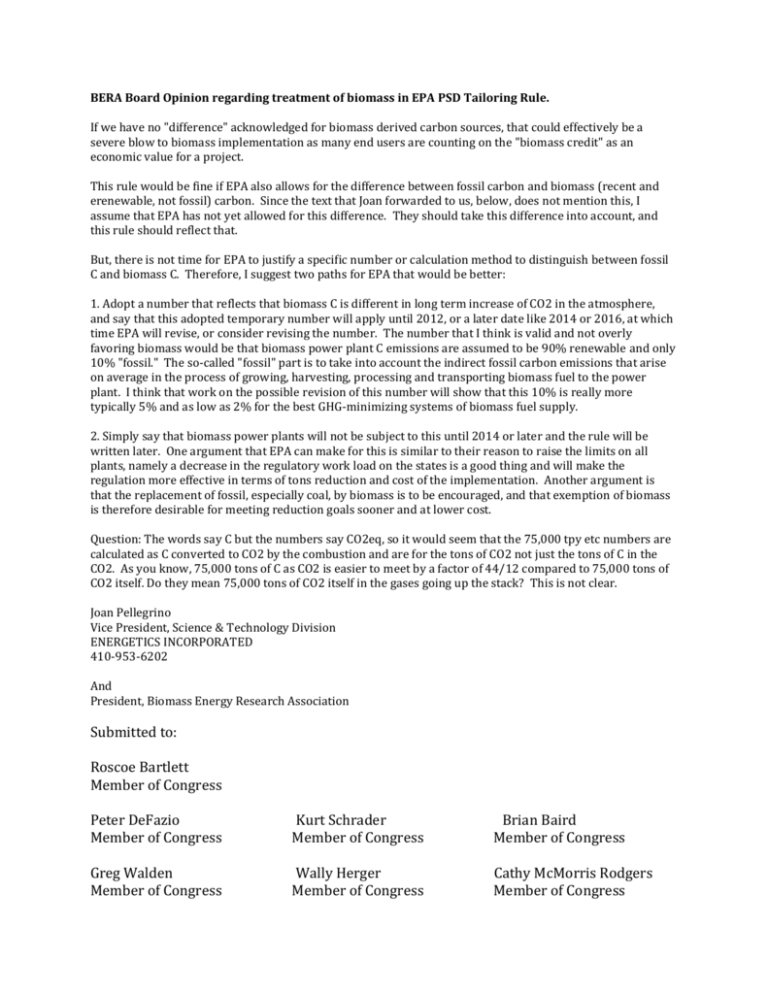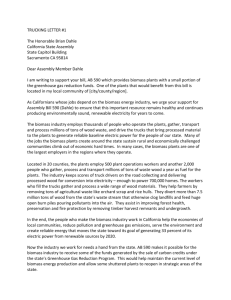BERA Board Opinion Regarding Treatment of Biomass in EPA PSD
advertisement

BERA Board Opinion regarding treatment of biomass in EPA PSD Tailoring Rule. If we have no "difference" acknowledged for biomass derived carbon sources, that could effectively be a severe blow to biomass implementation as many end users are counting on the "biomass credit" as an economic value for a project. This rule would be fine if EPA also allows for the difference between fossil carbon and biomass (recent and erenewable, not fossil) carbon. Since the text that Joan forwarded to us, below, does not mention this, I assume that EPA has not yet allowed for this difference. They should take this difference into account, and this rule should reflect that. But, there is not time for EPA to justify a specific number or calculation method to distinguish between fossil C and biomass C. Therefore, I suggest two paths for EPA that would be better: 1. Adopt a number that reflects that biomass C is different in long term increase of CO2 in the atmosphere, and say that this adopted temporary number will apply until 2012, or a later date like 2014 or 2016, at which time EPA will revise, or consider revising the number. The number that I think is valid and not overly favoring biomass would be that biomass power plant C emissions are assumed to be 90% renewable and only 10% "fossil." The so-called "fossil" part is to take into account the indirect fossil carbon emissions that arise on average in the process of growing, harvesting, processing and transporting biomass fuel to the power plant. I think that work on the possible revision of this number will show that this 10% is really more typically 5% and as low as 2% for the best GHG-minimizing systems of biomass fuel supply. 2. Simply say that biomass power plants will not be subject to this until 2014 or later and the rule will be written later. One argument that EPA can make for this is similar to their reason to raise the limits on all plants, namely a decrease in the regulatory work load on the states is a good thing and will make the regulation more effective in terms of tons reduction and cost of the implementation. Another argument is that the replacement of fossil, especially coal, by biomass is to be encouraged, and that exemption of biomass is therefore desirable for meeting reduction goals sooner and at lower cost. Question: The words say C but the numbers say CO2eq, so it would seem that the 75,000 tpy etc numbers are calculated as C converted to CO2 by the combustion and are for the tons of CO2 not just the tons of C in the CO2. As you know, 75,000 tons of C as CO2 is easier to meet by a factor of 44/12 compared to 75,000 tons of CO2 itself. Do they mean 75,000 tons of CO2 itself in the gases going up the stack? This is not clear. Joan Pellegrino Vice President, Science & Technology Division ENERGETICS INCORPORATED 410-953-6202 And President, Biomass Energy Research Association Submitted to: Roscoe Bartlett Member of Congress Peter DeFazio Member of Congress Kurt Schrader Member of Congress Brian Baird Member of Congress Greg Walden Member of Congress Wally Herger Member of Congress Cathy McMorris Rodgers Member of Congress









